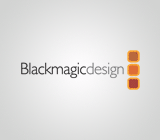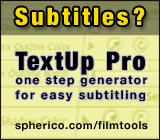|
|
Forum List
>
Café LA
>
Topic
Lots of resolutions in an HD sequence
Posted by DCA_Film
|
Lots of resolutions in an HD sequence May 13, 2009 01:01PM |
Registered: 15 years ago Posts: 34 |
Greetings,
I am working with (project) which is 1920x1080 24p.(apple prores 422 HQ)
I have footage which is, HDV in the 1080i format, that is HDV in 1080p, pal, dv, BetaSP, 720p, ummm DVCPRO HD, 1920x108050i, 1920x1080 60i in pro res, as well as native 1920x108024p
My question is how good of a job does FCP 6.0.5 do in scaling all the various resolutions/frame rates?
I am going to convert the HDV to ProRes via the media manager since I have a few layers.
I am having to upcovert all of my SD footage to 1920x1080 (Red Giant After Effects plug in).
Do I bit the bullet and do all of the HDV, DVCPROD, and 720p as well?
My project is being projected via panasonic 7700 projector with an image size in the 20' range.
Any thoughts would be appreciated.
Andrew
I am working with (project) which is 1920x1080 24p.(apple prores 422 HQ)
I have footage which is, HDV in the 1080i format, that is HDV in 1080p, pal, dv, BetaSP, 720p, ummm DVCPRO HD, 1920x108050i, 1920x1080 60i in pro res, as well as native 1920x108024p
My question is how good of a job does FCP 6.0.5 do in scaling all the various resolutions/frame rates?
I am going to convert the HDV to ProRes via the media manager since I have a few layers.
I am having to upcovert all of my SD footage to 1920x1080 (Red Giant After Effects plug in).
Do I bit the bullet and do all of the HDV, DVCPROD, and 720p as well?
My project is being projected via panasonic 7700 projector with an image size in the 20' range.
Any thoughts would be appreciated.
Andrew
|
Re: Lots of resolutions in an HD sequence May 13, 2009 01:12PM |
Moderator Registered: 16 years ago Posts: 3,410 |
Quote
My question is how good of a job does FCP 6.0.5 do in scaling all the various resolutions/frame rates?
Terrible.
Mixing pixel aspect ratios is something you can get away with. Mixing, for example, DVCPRO HD at 1280x1080 and uncompressed at 1920x1080 is okay.
Mixing raster sizes is dicier. You could probably get away with cutting uncompressed 720p24 into an uncompressed 1080p24 timeline, as long as you didn't mix and match a lot. I wouldn't let Final Cut upconvert 480p24 to 1080p24, however. I'd do that with Compressor instead, or a hardware solution.
Mixing frame rates is an absolute no-no. If you just had 60i and 24p material, no problem; add 3:2 pulldown to the 24p material and call it a day. But you're having to intercut NTSC-rate material with PAL-rate material, and that's just never okay. You really need to run the PAL-rate stuff through a standards converter ? an Alchemist, say ? in order to convert it. I know you can batch-process PAL-rate material to NTSC-rate material with Compressor, but I've never tried it personally.
The only question you didn't answer is what your delivery format is. In an ideal world, the bulk of your footage would be in the format you're planning to deliver ? at least in the right frame rate ? and you'd only have to convert a little material. Is that the case?

|
Re: Lots of resolutions in an HD sequence May 13, 2009 01:30PM |
Registered: 17 years ago Posts: 5,764 |
Getting a capture card to do this would be FAR better. The Matrox MXO2 or AJA Kona LHi are both in the $1500-$1600 range and do this well. better than Instant HD and Compressor. Instant HD needs the footage to already be progressive. It doesn't work with interlaced footage well, that is the one drawback.
When you have that much footage in such varying formats, it is wise to convert everything to the same codec, same frame rate (frame rate is the BIGGEST issue) and a capture card is the best way to do this.

www.shanerosseditor.com
Listen to THE EDIT BAY Podcast on iTunes
[itunes.apple.com]
When you have that much footage in such varying formats, it is wise to convert everything to the same codec, same frame rate (frame rate is the BIGGEST issue) and a capture card is the best way to do this.

www.shanerosseditor.com
Listen to THE EDIT BAY Podcast on iTunes
[itunes.apple.com]
|
Re: Lots of resolutions in an HD sequence May 13, 2009 02:03PM |
Registered: 15 years ago Posts: 34 |
The final output will be to a HD server and it will be compressed at a high bit rate via MPEG Pro.
I have a Kona LHe Capture card but that is not the issue when you are purchasing stock footage, and have a limited time, budget, and can't spend 4k on labs to get it all in order.
A majority of the footage is 50i 25fps which when inter-cut with the 23.97 looks acceptable.
note...Just did a test projection straight off the Kona Card.
I am more worried about going from NTSC to 24p than I am the PAL.
I will do a vast majority of the work in AE it sounds like.
Thanks for the fast response!
I have a Kona LHe Capture card but that is not the issue when you are purchasing stock footage, and have a limited time, budget, and can't spend 4k on labs to get it all in order.
A majority of the footage is 50i 25fps which when inter-cut with the 23.97 looks acceptable.
note...Just did a test projection straight off the Kona Card.
I am more worried about going from NTSC to 24p than I am the PAL.
I will do a vast majority of the work in AE it sounds like.
Thanks for the fast response!
|
Re: Lots of resolutions in an HD sequence May 13, 2009 03:04PM |
Moderator Registered: 16 years ago Posts: 3,410 |
Quote
The final output will be to a HD server and it will be compressed at a high bit rate via MPEG Pro.
This is, unfortunately, not an answer. You're going to have some kind of mastering format ? HDCAM SR, D5 HD, DVCPRO HD, whatever ? that subsequently gets turned into your delivery format. What should dictate your working format is what your mastering format needs to be.
The LHe ? which is what I have ? won't do real-time upconversions on capture. The new LHi will, as will the pricier 2K-savvy Kona 3.
I guess cutting 50i material into a 24p timeline can look "acceptable," depending on your definition of "acceptable."

|
Re: Lots of resolutions in an HD sequence May 13, 2009 03:21PM |
Registered: 17 years ago Posts: 5,764 |
>"This is, unfortunately, not an answer. You're going to have some kind of mastering format ? HDCAM SR, D5 HD, DVCPRO HD, whatever ? that subsequently gets turned into your delivery format."
Uh, not necessarily. I know a few people who are required to deliver their shows on drives already compressed in the broadcast MPEG-2 format. And a few more who do that to avoid outputting to tape first.
Upconverting SD to HD is easy with the LHi and MXO 2 and Kona 3 (yeah, the LHe can't do this). But STANDARDS CONVERSION is another matter. You can look at www.nattress.com STANDARDS CONVERTER for this...demo available. Otherwise you need to send out to be converted. Unless you like what Compressor can do...I don't.

www.shanerosseditor.com
Listen to THE EDIT BAY Podcast on iTunes
[itunes.apple.com]
Uh, not necessarily. I know a few people who are required to deliver their shows on drives already compressed in the broadcast MPEG-2 format. And a few more who do that to avoid outputting to tape first.
Upconverting SD to HD is easy with the LHi and MXO 2 and Kona 3 (yeah, the LHe can't do this). But STANDARDS CONVERSION is another matter. You can look at www.nattress.com STANDARDS CONVERTER for this...demo available. Otherwise you need to send out to be converted. Unless you like what Compressor can do...I don't.

www.shanerosseditor.com
Listen to THE EDIT BAY Podcast on iTunes
[itunes.apple.com]
|
Re: Lots of resolutions in an HD sequence May 13, 2009 03:23PM |
Registered: 15 years ago Posts: 34 |
|
Re: Lots of resolutions in an HD sequence May 13, 2009 05:26PM |
Registered: 15 years ago Posts: 34 |
|
Re: Lots of resolutions in an HD sequence May 14, 2009 06:08AM |
Moderator Registered: 16 years ago Posts: 3,410 |
Quote
I know a few people who are required to deliver their shows on drives already compressed in the broadcast MPEG-2 format.
Fair point, Shane. That's especially true for spot delivery. But even in those cases, there's some kind of mastering format, in my experience. It's always either D5, HDCAM SR or Digibeta in my experience, though I believe you when you say some folks skip the tape-out part of the process. But even if you're doing a tapeless edit, you're still going to want some kind of master for archival purposes, right? Even if it's, say, an uncompressed Quicktime written to LTO or something?

|
Re: Lots of resolutions in an HD sequence May 14, 2009 04:26PM |
Registered: 15 years ago Posts: 34 |
|
Re: Lots of resolutions in an HD sequence June 20, 2009 01:13AM |
Registered: 15 years ago Posts: 1 |
Hi,
I've gathered lots of useful info already, but I still would appreciate some advice.
I am doing a documentary with lots of material from different sources.
Most stuff shot for the documentary are HDV 1050i (PAL), but there are lots of archive material: VHS, Betamax, 35mm film on digibeta, DVCAM, lots of photoes etc.
Can I edit natively on HDV timeline ( put everything there, sort of offline) then make new project via media manager and recompress everything to Pro res and then color correct etc.
Delivery format will be SD master on Digibeta. (I will output using Blackmagic card).
or... Can I start to edit straight to Apple pro res timeline??
Any advice much appreciated.
Vidamonte
I've gathered lots of useful info already, but I still would appreciate some advice.
I am doing a documentary with lots of material from different sources.
Most stuff shot for the documentary are HDV 1050i (PAL), but there are lots of archive material: VHS, Betamax, 35mm film on digibeta, DVCAM, lots of photoes etc.
Can I edit natively on HDV timeline ( put everything there, sort of offline) then make new project via media manager and recompress everything to Pro res and then color correct etc.
Delivery format will be SD master on Digibeta. (I will output using Blackmagic card).
or... Can I start to edit straight to Apple pro res timeline??
Any advice much appreciated.
Vidamonte
Sorry, only registered users may post in this forum.



 All the news now and in your digital future
All the news now and in your digital future